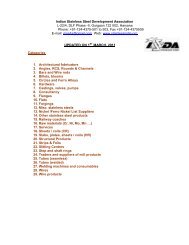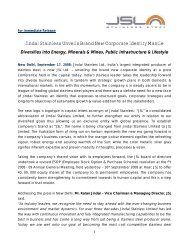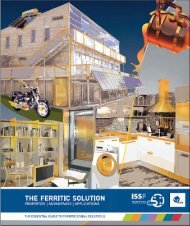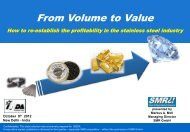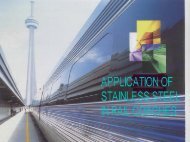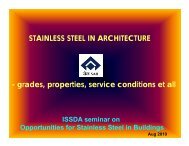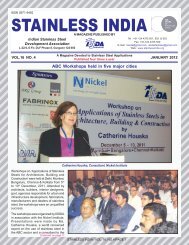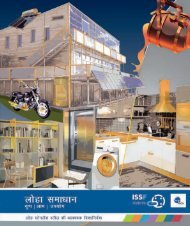Good Shop Floor Practices - Indian Stainless Steel Development ...
Good Shop Floor Practices - Indian Stainless Steel Development ...
Good Shop Floor Practices - Indian Stainless Steel Development ...
Create successful ePaper yourself
Turn your PDF publications into a flip-book with our unique Google optimized e-Paper software.
Ramesh R. Gopal, ISSDAAugust 21, 2010Ahmedabad
Carbon <strong>Steel</strong><strong>Stainless</strong> <strong>Steel</strong>ReactiveRust formationNeeds Paint ProtectionPassiveNo rustingNo need
This is usually because tiny particlesof iron are embedded on the surfaceof stainless steel during fabrication.This iron is what is rusting. Not thestainless steel itself. This is quite acommon problem and can be easilyavoided.
If you choose the right grade andfabricate it properly, you can do morewith stainless steel than you can withcarbon steel
Original Appearance
Carbon <strong>Steel</strong> being cut nearby
Sparks of carbon steel rain on stainlesssteel product
Do not store on the work floor or walk onthem
Shoe marks are full of contaminationfrom shop floor
Use wood or plastic separators on shelves.Mild steel shelves should not be in directcontact with stainless steel
Do not use mild steel ropes for lifting
Use non-metallic straps
Grinding wheels should be dedicated for useonly on stainless steel; Do not ever use themon carbon steel.
Use only stainless steel brushes
Do not mark with crayon on bare sheets.Mark on Polythene protective sheets
<strong>Good</strong> <strong>Practices</strong>• Layer vice with thin sheets of tack-weldedstainless steel at the jaws.• Mild steel work tables should also be coveredwith either stainless steel or aluminium sheets toprevent direct rubbing or dragging over mildsteel.• Finally, a dedicated work space would be bestbecause carbon steel welding fumes in the shedwould condense overnight on the surfaces ofstainless steel raw materials or products inprocess.
You need to clean heat tints. They reducecorrosion resistance.
Physical properties of SS and CS contd.Austenitic<strong>Stainless</strong><strong>Steel</strong>ThermalExpansionover rangeindicatedin./in./C x 10 -6 17.6(20-500ºC)Carbon<strong>Steel</strong>11.7(20-628ºC)RemarksType 304 expands and contracts ata faster rate than CS, which meansthat increased expansion andcontraction must be allowed for inorder to control warping and thedevelopment of thermal stressesupon cooling. For example, moretack welds are used for SS than forCS.
Physical properties of SS and CS contd.Austenitic<strong>Stainless</strong>Carbon<strong>Steel</strong>Remarks<strong>Steel</strong>Rate of heatconductivity% at 100 ºC% at 650 ºC(Type 304)28 %66 %100 %100 %Type 304 conducts heat much moreslowly than CS thus promotingsharper heat gradients. Thisaccelerates warping, especially incombination with higher expansionrates. Slower diffusion of heatexpansion through base metalmeans that weld zones remain hotlonger, one result of which may belonger dwell in the carbideprecipitation range unless excessheat is artificially removed by chillbars, etc.
Control distortion with fixtures and tacks
Note the close location of tacks
NiDI
NiDI
NiDI
NiDI
Avoid DistortionFirst weldsNiDI
A good fit-up•Reduces welding time•Reduces dressing cost•Improves the welded joint appearanceNiDI
Bad Fit-upThree commonmistakes.NiDI
<strong>Good</strong> Fit-upNiDI
Minimize Site fabrication•Site conditions are never ideal•Difficult to obtain the same qualityas in the workshop•Design and plan to minimise sitework.NiDI
Site fabricationNiDI
Some ImportantDesignConsiderationsDesign for DrainageMaximize natural drainage.Minimize cleaning costs.Provide forCleaning
Avoid crevicesSeal joints or makewide enough to drainfreely and avoidcrevice corrosion.
Fasteners & Galvanic CorrosionDO NOT USE carbon steel (galvanized /plated) fasteners on SS products.Brass fasteners can be considered.SS fasteners of the same grade are ideal
SS fasteners on carbon steel components– negligible bimetallic corrosion.
LocationIf stainless steel elements are locatedin sheltered and inaccessible areassuch as under-the-eaves, they aredenied the benefit of natural cleaningby rain, wind and sunshine.In addition, such locations tend to havemore humidity levels than exposedlocations, thereby adding to thecorrosiveness of the environment.
It is advisable notto locate stainlesssteel elements insuch locations.If you must usestainless steel,make sure aregular cleaningregimen ismandated.




